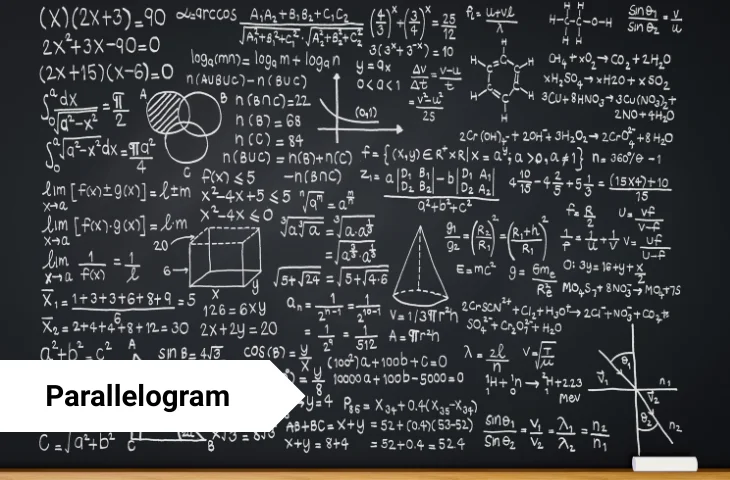In Quantitative Aptitude, Parallelogram is an important subtopic of Geometry that often appears in SSC, Banking, and Railway exams. It tests your knowledge of shape properties, mensuration formulas, and logical application of geometry concepts. In this blog we have provided all the details on parallelogram from the definition, formulas, types, tricks, solved examples, and more.
What Is Parallelogram in Quantitative Aptitude?
A Parallelogram is a quadrilateral in which both pairs of opposite sides are parallel and equal in length. Opposite angles are equal, and adjacent angles are supplementary.
Why it appears in exams:
- Checks geometry fundamentals.
- Tests knowledge of direct formulas & properties for perimeter, area, and angles.
Skills required:
- Shape visualization
- Formula recall & application
- Understanding of parallel lines and angle properties
Why Is Parallelogram Important in Competitive Exams?
Parallelogram problems are common in SSC CGL, IBPS PO, and RRB exams because they are formula-based and easy to solve.
| Exam | No. of Questions | Difficulty |
| SSC CGL / CHSL | 1–2 | Easy |
| IBPS PO / SBI PO | 1–2 | Moderate |
| RRB NTPC / Group D | 1 | Easy |
| State PSC / Police | 1–2 | Moderate |
Parallelogram Quantitative Aptitude Short Notes
Short notes based on the topic parallelogram are as follows:
| Term | Details |
| Sides | Opposite sides are parallel & equal |
| Angles | Opposite angles are equal |
| Adjacent angles | Supplementary (sum to 180°) |
| Diagonals | Bisect each other |
| Area | Base × Height |
| Perimeter | 2 × (Sum of adjacent sides) |
| Special cases | Rectangle, rhombus, square |
Important Parallelogram Concepts
Important concepts used to solve parallelogram questions are as follows:
| Concept | Details |
| Opposite sides | Equal & parallel |
| Opposite angles | Equal |
| Adjacent angles | Supplementary |
| Diagonals | Bisect each other |
| Area formula | Base × Height |
| Perimeter formula | 2 × (a + b) |
What Are the Types of Parallelogram Questions in Quantitative Aptitude?
Different types of questions based on the topic of parallelograms are as follows:
- Direct formula-based: Find area or perimeter.
- Property-based: Angle/side problems using properties.
- Diagram-based: Identify missing values using given dimensions.
- Mixed problems: Combined with trigonometry or coordinate geometry.
Parallelogram Formulas for Quantitative Aptitude
Formulas used to solve parallelogram questions are as follows:

Parallelogram Tricks for SSC CGL and Other Exams
Tricks to solve parallelogram questions are as follows:
- If height is missing, use area formula in reverse.
- Opposite sides equal only two distinct side values.
- Use adjacent angles sum = 180° to find unknown angles.
- For coordinate geometry, use vector or cross product methods for area.
- If a question mentions “equal diagonals” it’s a rectangle, not just a parallelogram.
Solved Parallelogram Questions from 2024–25 Exams

Common Mistakes to Avoid while Solving Parallelogram Questions
Common mistakes to avoid while solving parallelogram questions are as follows:
- Assuming diagonals are equal in all parallelograms.
- Forgetting to use height, not slant side, in area formula.
- Confusing adjacent angles as equal (they are supplementary).
- Ignoring special cases (rectangle, square, rhombus).
- Mixing perimeter formula with area formula.
FAQs
Rectangle, rhombus, square.
They are supplementary.
Cosine rule or Pythagoras theorem in special cases.
Yes, with all sides equal but angles not necessarily 90°.
Only if both pairs of opposite sides are parallel (which makes it a parallelogram).
- IBPS PO Mains Scorecard 2025 Out, Check and Download Marksheet
- SSC CGL Tier 2 Study Plan 2025 for Last 15 Days Before Exam
- SBI SCO Salary 2025, In Hand Salary, Perks and Allowances
- SBI SCO Syllabus and Exam Pattern 2025, Post-Wise Syllabus
- SBI SCO Recruitment 2025, 996 Posts, Apply Now
- IBPS PO Personality Test 2025 Pattern, Questions, Dates

Hi, I’m Aditi. I work as a Content Writer at Oliveboard, where I have been simplifying exam-related content for the past 4 years. I create clear and easy-to-understand guides for JAIIB, CAIIB, and UGC exams. My work includes breaking down notifications, admit cards, and exam updates, as well as preparing study plans and subject-wise strategies.
My goal is to support working professionals in managing their exam preparation alongside a full-time job and to help them achieve career growth.
